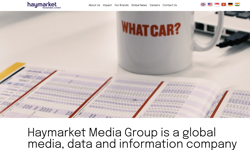Among the many wonderful, globe-connecting, mind-expanding aspects of the internet, a sub-phenomenon is that it is now not only possible, but more or less mandatory, for those in the media to be aware, on a moment-to-moment basis, of every development within our own industry, however important or minor.
E-newsletters, e-alerts and even e-magazines covering every sector and aspect of the media announce themselves in our e-inboxes throughout the day.
This, too, is largely to the good, of course. These days, we all need as much help as possible to stay on our toes.
But since it’s always been the nature of news to be largely negative, we don’t read a lot that’s uplifting about our industry. We read mostly about magazine closings, buy-outs, declining advertising, declining circulation and / or readership, restructurings, lay-offs and painful partings-of-the ways. (On the upside, at least we can send timely notes of condolence to our colleagues…)
What once might have been a relatively unremarkable corporate or personal setback, conveyed mostly by word-of-mouth, now becomes the industry crisis of the moment, dissected in excruciating detail and retrospective insight from every e-corner. People watch the print advertising statistics with the same fervour once reserved for football results.
Only a dolt would try to pretend that the magazine industry is not facing unprecedented challenges. Yet, there is a certain self-fulfilling element to negativism. And is there anyone out there who hasn’t found him or herself occasionally wondering: Is it all really that desperate?
So, just for a change of pace, let’s take a look at some of the key issues that US consumer magazine publishers will be immersed in in 2006, and imagine what could ultimately transpire if we stop resisting change and, instead, embrace it.
* Media integration
Magazine publishers large and small become more aggressive and effective at leveraging their powerful brands. They create and implement formal, strategic programs for making calculated investments in natural cross-media launches and developing suitable cross-media partnerships. They force people now working in silos on print and electronic products, and professionals from all functions, to work closely together — not just on a project basis, but day to day. They create genuinely integrated marketing programs for clients. They invest in training their salespeople to understand and sell new media and tailored, integrated solutions (a process entailing up to a year, not five days).
* Advertising / circulation
Consumer publishers at long last stop beating up on one another and playing circulation games, and start to boldly, openly and cooperatively promote magazines’ strengths to media buyers.
They purge their files of paid-but-not-really subscriptions. They reduce their paid circ guarantees, and stand up and educate media buyers about the real value that well-managed and audited controlled circulation (and even free, non-controlled circ) can bring to advertisers and publishers alike (namely, reaching large numbers of targeted new prospects). They tell media buyers who refuse to pay for non-paid circ such as physicians’ waiting room copies (which, in reality, can be excellent for advertisers, because of their high readers-per-copy and solid demographics): ‘Fine. Then we’ll simply leave your ad out of those copies.’
They begin working together, and with the advertising community, on new metrics to supplement and enhance magazines’ story. Many media buyers have made it clear that they’re not about to agree to dropping the independent circulation audits that provide fundamental distribution insurance. But they’re certainly interested in speedier audited data (which is why BPA is creating an online reporting system to enable by-issue reporting of top-line circulation data). And they’re certainly eager to find new ways to measure reader involvement. One possibility, that will be looked at this year, is Readership.com, a new system that proposes to combine top-line circ data and a reader ‘engagement’ index.
While they’re at it, maybe publishers will even start laying the groundwork for dispensing with, or reinventing, the whole concept of rate base, in favour of a system that reflects the reality that magazine circulation has natural ebb and flow from issue to issue. (It’s certainly possible to envision a system wherein, in return for more timely, by-issue data, advertisers agree to an acceptable, predetermined plus-or-minus variable range, and pay less - or more — if the magazine misses or exceeds that range.)
* Production
Through the work of the IDEAlliance, an association of media, information, printing and production companies, long lead times for magazine advertising materials have been significantly reduced in recent years. But if publishers are to compete effectively with TV and new electronic media, there’s more work ahead in this respect — as well as a need to reduce the time - and money-wasting paper trails involved in buying magazine ads.
And lo and behold, Jack Kliger, president/CEO of Hachette Filipacchi Media US and the new chair of Magazine Publishers of America, has just called for major publishers to cooperate on a shared system for streamlining advertising ordering, placement and payment.
Some are already saying that head-on competitors won’t go for this, even though there would be no shared sales process — just cooperation on the back end. But in line with my self-declared optimistic theme for this issue, I’m predicting that, with time and hard work, a solution will be worked out.
And, come to think of it, that’s true of pretty much every challenge, isn’t it?
FEATURE
What 2006 Ought to Look Like
We love a crisis! Some in our industry seem to put more energy into moaning about the latest (or imminent) crisis than they do into solving it. At the start of a new year, Karlene Lukovitz breaks free from the prevailing negativism to sound a more up beat note.










